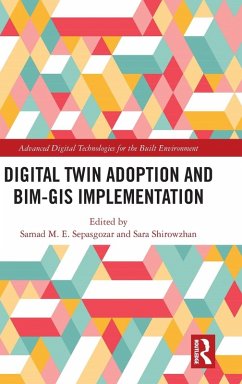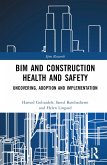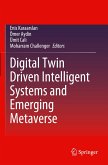Digital Twin Adoption and BIM-GIS Implementation
Herausgeber: Sepasgozar, Samad; Shirowzhan, Sara
Digital Twin Adoption and BIM-GIS Implementation
Herausgeber: Sepasgozar, Samad; Shirowzhan, Sara
- Gebundenes Buch
- Merkliste
- Auf die Merkliste
- Bewerten Bewerten
- Teilen
- Produkt teilen
- Produkterinnerung
- Produkterinnerung
The aim of this edited book volume is to present new concepts, case studies and applications of Digital Twin and relevant tools in the built environment context.
Andere Kunden interessierten sich auch für
![Getting to Grips with BIM Getting to Grips with BIM]() James HartyGetting to Grips with BIM73,99 €
James HartyGetting to Grips with BIM73,99 €![BIM and Quantity Surveying BIM and Quantity Surveying]() BIM and Quantity Surveying253,99 €
BIM and Quantity Surveying253,99 €![Building Information Modelling (BIM) in Design, Construction and Operations IV Building Information Modelling (BIM) in Design, Construction and Operations IV]() Building Information Modelling (BIM) in Design, Construction and Operations IV178,99 €
Building Information Modelling (BIM) in Design, Construction and Operations IV178,99 €![BIM and Construction Health and Safety BIM and Construction Health and Safety]() Hamed GolzadBIM and Construction Health and Safety220,99 €
Hamed GolzadBIM and Construction Health and Safety220,99 €![Digital Twin - Fundamental Concepts to Applications in Advanced Manufacturing Digital Twin - Fundamental Concepts to Applications in Advanced Manufacturing]() Surjya Kanta PalDigital Twin - Fundamental Concepts to Applications in Advanced Manufacturing137,99 €
Surjya Kanta PalDigital Twin - Fundamental Concepts to Applications in Advanced Manufacturing137,99 €![Digital Twin Driven Intelligent Systems and Emerging Metaverse Digital Twin Driven Intelligent Systems and Emerging Metaverse]() Digital Twin Driven Intelligent Systems and Emerging Metaverse131,99 €
Digital Twin Driven Intelligent Systems and Emerging Metaverse131,99 €![Adoption of Robots for Disasters Adoption of Robots for Disasters]() Robin R. MurphyAdoption of Robots for Disasters74,99 €
Robin R. MurphyAdoption of Robots for Disasters74,99 €-
-
-
The aim of this edited book volume is to present new concepts, case studies and applications of Digital Twin and relevant tools in the built environment context.
Hinweis: Dieser Artikel kann nur an eine deutsche Lieferadresse ausgeliefert werden.
Hinweis: Dieser Artikel kann nur an eine deutsche Lieferadresse ausgeliefert werden.
Produktdetails
- Produktdetails
- Verlag: Routledge
- Seitenzahl: 224
- Erscheinungstermin: 9. August 2024
- Englisch
- Abmessung: 240mm x 161mm x 17mm
- Gewicht: 505g
- ISBN-13: 9781032569338
- ISBN-10: 1032569336
- Artikelnr.: 70147532
- Herstellerkennzeichnung
- Libri GmbH
- Europaallee 1
- 36244 Bad Hersfeld
- gpsr@libri.de
- Verlag: Routledge
- Seitenzahl: 224
- Erscheinungstermin: 9. August 2024
- Englisch
- Abmessung: 240mm x 161mm x 17mm
- Gewicht: 505g
- ISBN-13: 9781032569338
- ISBN-10: 1032569336
- Artikelnr.: 70147532
- Herstellerkennzeichnung
- Libri GmbH
- Europaallee 1
- 36244 Bad Hersfeld
- gpsr@libri.de
Samad M. E. Sepasgozar is a top 2% researcher in the world computed by the Standard University and the first top researcher (field leader in Architecture) in Australia found by The Australian. He is an academic editor (editorial board member) at Scientific Reports Nature and Associate Editor of Architectural Engineering ASCE (Decile 1). He is also a top 1% reviewer globally, an editor, editorial board member, or reviewer for 60 leading high¿ranked journals, and a lead assessor for national research projects on innovation and smart technologies. He published over 200 peer¿reviewed articles and received various international and national awards annually. He is an Associate Professor at the University of New South Wales (top 19 globally), Sydney, Australia. Sara Shirowzhan is a Senior Lecturer and the Co-convenor of smart cities and infrastructure cluster in the School of Built Environment at the University of New South Wales (UNSW), Sydney, Australia. Her areas of research in technologies relevant to built¿environment informatics include sensing technologies, advanced GIS, BIM, Digital Twins, and Artificial Intelligence. She teaches and supervises students on Construction Informatics, City Analytics, GIS, and BIM¿relevant topics at undergrad and postgrad levels. She is currently an Editorial Board member of the Journal of Sustainability and Advances in Civil Engineering. She is also a Topic Board member of the ISPRS International Journal of GeöInformation. She completed her PhD in Geomatics Engineering from the School of Civil and Environmental Engineering at UNSW.
Chapter 1: Introduction
Chapter 2: Organisational factors affecting digital technology adoption in
the architecture industry: a systematic literature review
Chapter 3: Digital twin maturity and readiness metrics for assessing
practitioners' intention to use: model development and multi-group
structural analysis
Chapter 4: Digital twin adoption modelling incorporating job relevance,
usefulness, and relative advantage: an empirical investigation
Chapter 5: Immersive virtual environments and digital twin applications for
education and training: trends in construction, mining and urban planning
studies
Chapter 6: Digital twin for urban decision support systems: scientometric
and thematic analysis
Chapter 7: Web-based BIM-GIS integration workflows for making cities'
digital twin 3D models
Chapter 8: BIM and GIS values and acceptance criteria in government-funded
infrastructure projects: a case study of Australia
Chapter 2: Organisational factors affecting digital technology adoption in
the architecture industry: a systematic literature review
Chapter 3: Digital twin maturity and readiness metrics for assessing
practitioners' intention to use: model development and multi-group
structural analysis
Chapter 4: Digital twin adoption modelling incorporating job relevance,
usefulness, and relative advantage: an empirical investigation
Chapter 5: Immersive virtual environments and digital twin applications for
education and training: trends in construction, mining and urban planning
studies
Chapter 6: Digital twin for urban decision support systems: scientometric
and thematic analysis
Chapter 7: Web-based BIM-GIS integration workflows for making cities'
digital twin 3D models
Chapter 8: BIM and GIS values and acceptance criteria in government-funded
infrastructure projects: a case study of Australia
Chapter 1: Introduction
Chapter 2: Organisational factors affecting digital technology adoption in
the architecture industry: a systematic literature review
Chapter 3: Digital twin maturity and readiness metrics for assessing
practitioners' intention to use: model development and multi-group
structural analysis
Chapter 4: Digital twin adoption modelling incorporating job relevance,
usefulness, and relative advantage: an empirical investigation
Chapter 5: Immersive virtual environments and digital twin applications for
education and training: trends in construction, mining and urban planning
studies
Chapter 6: Digital twin for urban decision support systems: scientometric
and thematic analysis
Chapter 7: Web-based BIM-GIS integration workflows for making cities'
digital twin 3D models
Chapter 8: BIM and GIS values and acceptance criteria in government-funded
infrastructure projects: a case study of Australia
Chapter 2: Organisational factors affecting digital technology adoption in
the architecture industry: a systematic literature review
Chapter 3: Digital twin maturity and readiness metrics for assessing
practitioners' intention to use: model development and multi-group
structural analysis
Chapter 4: Digital twin adoption modelling incorporating job relevance,
usefulness, and relative advantage: an empirical investigation
Chapter 5: Immersive virtual environments and digital twin applications for
education and training: trends in construction, mining and urban planning
studies
Chapter 6: Digital twin for urban decision support systems: scientometric
and thematic analysis
Chapter 7: Web-based BIM-GIS integration workflows for making cities'
digital twin 3D models
Chapter 8: BIM and GIS values and acceptance criteria in government-funded
infrastructure projects: a case study of Australia








